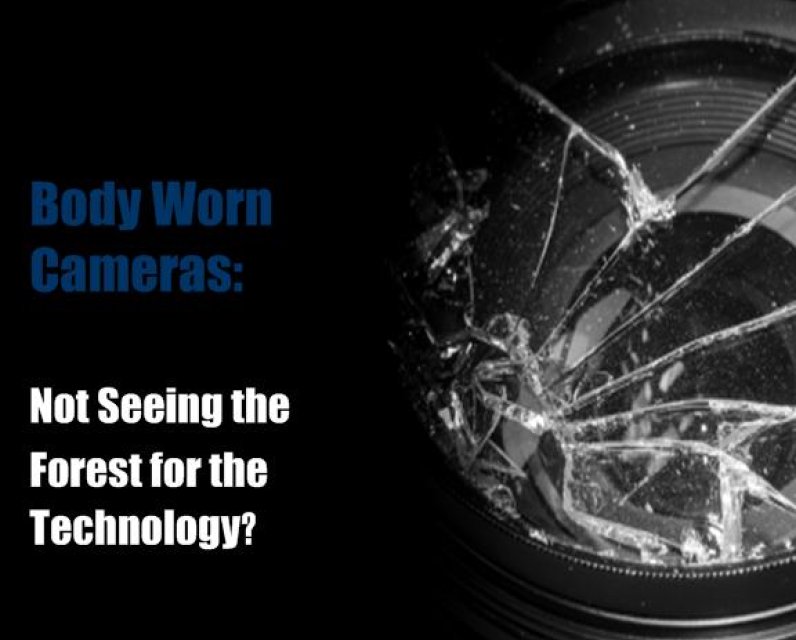Unpublished Opinions
Body-Worn Cameras: Not Seeing the Forest for the Technology?

In Canada, body-worn technology seemed to emerge over night but in actuality has been tested and implemented over the past few years by North American law enforcement, with one early adopter being Canadian. While there is no disputing the increased popularity of body-worn cameras, high adoption rates have been marred by high costs, technology issues and research findings that are inconsistent and causally inconclusive.
========================================
This article is based on a report written by Valarie Findlay, which was an unsanctioned and independent review and analysis of existing literature on body-worn camera technology, found here:
https://www.researchgate.net/publication/312234531_Body-Worn_Cameras_Not...
For many Canadian law enforcement organizations, getting their feet wet with the technology as a pilot couldn't have happened fast enough. With several high profile incidents regarding officer use of force setting off public outcry and civil rights concerns in recent years, it may be a step in the right direction. However, several organizations have been pulling back after their pilots, mostly due to cost but some expressing uncertainty on how much body-worn cameras help with officer interactions with the public - and whether it will improve the behaviours of either in all situations.
Recently Ottawa Police Services announced they will be launching a body-worn camera pilot project to put the purported merits of the individually-worn devices to the test. Although the department announced they will roll out the project in 2017 to increase transparency and accountability, it is rumoured it may be a bit longer that that before a pilot comes to fruition.
But are they - and the public - ready for the challenges that come with the technology and are the expectations realistic?
Looking back at early body-worn camera programs, as in the pilot with Devon and Cornwall Police (UK), the operational focus was on improving evidentiary elements and preserving victim first-disclosure evidence. Now, current trends for use fall to transparency and posterity with the aim to reduce public complaints, unprofessional or inappropriate behaviours by law enforcement, as well as the public and as a diffusion tool to reduce use of force. Future use, once hurdles have been addressed, include enhancing intelligence, improving training and refining judicial processes.
In the US, the demand for body-worn cameras and rapid adoption have ramped up as a result of increased racial-conflicts and race-related shootings in interactions with police. In in the US in 2013, about 95% of the 17,500 state and local law enforcement agencies were either committed to body cameras or had completed their implementation, although 75% of those were not at full implementation and 5% had decided not to implement at all. Making this rate of adoption possible was substantial federal support with President Obama committing[1] $23 million in funding to body-worn camera programs for law enforcement in 2012 and another $75 million in 2014, part of a broader three-year, $263 million initiative aiming to strengthen community policing.
In Canada, funding rests at the organizational level and of the nearly 500 law enforcement organizations, several have proceeded with body-worn camera pilots in recent years with Toronto soon embarking on full program adoption. Leading the movement in 2013 was a small organization, Amherstburg Police Services in Ontario, who had fully implemented a body-worn camera program following their pilot project. However, there have also been issues. Recently several other cities - Edmonton, Calgary, Winnipeg and Vancouver, as well as the RCMP - have put their body-worn camera implementation efforts on hold, mostly due to storage costs.
So what does the research say? Generally, the case for adopting body-worn camera technology in law enforcement almost always points to three landmark studies - Rialto, Mesa and Phoenix - and now a recent study out of Cambridge in UK that was modelled on Rialto and authored by the same academic who led Rialto's study. Lauded as massive successes with substantial reductions in complaints and use of force, all four of these studies have revealed areas of concern in the post-analysis of their raw data - some presenting more questions than answers.
This is not to suggest that this research is unimportant or that body-worn cameras are ineffective but serves to reiterate that body-worn camera research shows a correlation - not causality - between use and their outcomes. Compounding this is that all of these studies differ in methodology, control criteria and organization characteristics, community size and community relations, making comparative assessments difficult. None so far have broached the sociological and behavioural aspects: is it the behaviour of the officer or member of the public (or if they are synchronous or symbiotic) that improves?
Rialto Police Department's year long pilot and study in 2013 suggested improvements but also that the effect of being observed during the experimental shifts may have encouraged pre-emptive moderating and the 'spill-over' effect, affecting officers who downloaded and viewed their own body-worn camera footage. As well, officers who wore cameras only half of the time may have been susceptible to a psychological awareness effect that improved future interactions. Also, closer examination of the raw data showed that the 59% reduction in use of force in all treatment shifts and 87% reduction in public complaints were formulated from a small number of incidents - twenty-five - and that the reductions in complaints were seen across both camera and non-camera groups.
Similarly, the Mesa Police Department pilot in 2012 revealed a reduction of 48% in "citizen complaints against camera officers for misconduct" during the study period and a 75% reduction in use of force complaints[2], noting that many complaints were resolved quickly due to the accessibility of video evidence. But the Mesa project also revealed concerns over discretionary activation policies, the pros/cons of volunteer and mandated officers, supervisory implications and lack of design controls to address avoidance factors.
Overall, the body-worn cameras did appear to be effective when worn in situations where there were verbal warnings of body-worn camera use[3], however, it was unclear why and in what instances and unintended bias and its management was suggested an impact to some of these favourable results. The concluding recommendations were that more controlled, replicable research was required.
More recently in 2016, the same author of the Rialto study, Barak Ariel, conducted the largest body-worn camera study on seven law enforcement organizations. Preliminary findings suggested that the overall effect on police use of force was "a wash" - in some instances, body-worn cameras reduced use of force but in others they didn't and may have exacerbated behaviours and increased use of force[4]; results were inconsistent and perplexing[5]. However, in the final report complaints by the public were reduced substantially, in one case to zero. Again, some of the above factors were raised as caveats to the findings.
The importance of this is not so much the possibility of skewed results, but that by relying on outcomes that are more correlative that causal, or more of a placebo in its factors, can set expectations artificially high and suggest a cost-benefit that may not exist at the moment. Its clear the effectiveness of body-worn cameras will depend on the organization, its stated uses and goals, measurements and success criteria and the rigorous execution of the pilot and/or adoption of the program.
In short, the value of body-worn camera technology as a tool for law enforcement organizations must be derived from cost benefit and return on investment. In the case of the Vancouver body-worn camera Police Department, the benefit could not be justified; they shelved their 600 unit body-worn camera program due to the $17 million price tag for equipment, storage and video recovery. It may be that waiting for the technology to "mature" is not the answer and looking beyond current technologies may be the game-changer.
For example, the Calgary Police Services addressed their storage cost issue by using an older technology - storage tapes - that reduced costs to about $1 million. Likewise, creative use of the video and upload technology quickly met the needs of civil rights groups and the public for police oversight with apps, such as "Hands Up for Justice" - these are free, available online and allow for recording and immediate uploading to YouTube or a Dropbox account.
As far as the acceptance of the technology by the public and by officers, most research shows high support but concerns over privacy exist for both and some officers and unions express concern over operational and practical impediments. Some have suggested "what's good for the goose is good for the gander": if patrol is equipped with body-cameras during their shifts, so should the executive (doubtful the Chiefs will be lining up for that!).
In the end, regardless of whether its the US or Canada, marrying the operational needs of law enforcement with the capabilities of body-worn camera technology, as well as interoperability and scalability with emerging technologies, like biometrics, voice recognition, telemetry and intelligence databases, may reveal a much more robust and effective tool that originally anticipated.
At the moment, Canadian law enforcement organizations are in a prime position to take a collaborative stance, glean from lessons learned from US and UK and lead innovation with their vendors. While affordability, adaptability and policy may be current barriers to adopting body-worn camera technology, the cost of complacency may be higher, should the tail be left to wag the dog.
This article is based on a report written by Valarie Findlay, which was an unsanctioned and independent review and analysis of existing literature on body-worn camera technology, found here:
https://www.researchgate.net/publication/312234531_Body-Worn_Cameras_Not...
[1] The White House Blog, President Obama's Plan to Strengthen Community Policing: http://www.whitehouse.gov/blog/2014/12/01/building-trust-between-communities-and-local-police
[2] AXON Flex Evaluation, ISSUU.com; Mesa, AZ: http://issuu.com/leerankin6/docs/final_axon_flex_evaluation_12-3-13-
[3] Ready, Justin T. and Young, Jacob T. N.; The impact of on-officer video cameras on police–citizen contacts: findings from a controlled experiment in Mesa, AZ
http://centerformediajustice.org/wp-content/uploads/2015/06/The-Impact-o...
[4]Ariel, Barak, Article: Do Police Body cameras Really Work?, Spectrum - IEEE, May 2016: http://spectrum.ieee.org/consumer-electronics/portable-devices/do-police...
[5] Preliminary Report on "Contagious Accountability": http://spectrum.ieee.org/consumer-electronics/portable-devices/do-police...



Comments
Be the first to comment